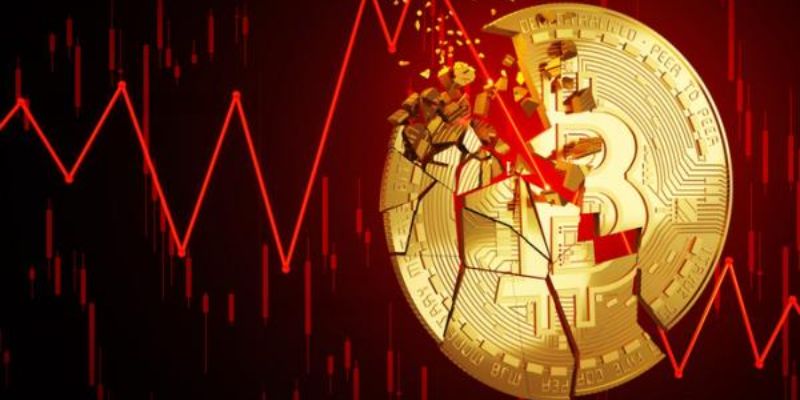What caused the crypto market crash? Explore the factors that led to the digital downfall, from complex economics to tech tangles. We’ll tackle the tough questions and give you clear answers. No jargon, just facts. Dive into the impact of policies, the fear-driven moves by traders, and the technical hiccups that hit wallets hard. Hodlers, investors, and the crypto-curious — this breakdown is for you. Get ready for a no-nonsense look at the unraveling of a market that shook the world.
Deciphering the Factors Behind the Cryptocurrency Downturn
Exploring Macroeconomic Policies and Their Impact
Let’s look at what affects the ups and downs of digital money. Big things like a country’s rules or when banks change interest rates can push prices around. It’s like when the Fed says it’s going to tighten up, which means they make it cost more to borrow money. This can scare folks in crypto, leading to lower prices.
Imagine a lot of people wanting to sell their Bitcoin at the same time. This can drive prices down fast. Why? Simple – too many sellers and not enough buyers. Also, if big countries like China say “No more crypto,” it can shake up the whole market.
Psychological Factors and Market Sentiment
Now let’s talk feelings. Yes, feelings! They play a huge role in crypto prices. When people get scared, they might sell their Ethereum or Bitcoin in a hurry. This is called panic selling. It spreads fast, and before you know it, prices have dropped a lot.
There’s also something called market sentiment. It’s like a mood for the market. When it’s good, people are happy to buy. But when it’s bad, watch out – the market can fall apart.
We saw this in action with the crypto bubble burst. A time when prices soared too high too fast, and then – pop! Everyone dashed to sell, crashing the market.
These are some of the twists and turns behind the wild ride in the world of digital money. It’s more than just computers and math. It’s about people, big decisions, and all the ups and downs that come with them.
The Technical and Regulatory Shake-Up
Analyzing Blockchain Vulnerabilities
You might wonder, “What role did tech issues play in the crash?” Well, blockchains are tough but not perfect. Even though they’re designed to be secure and stable, they can have weak spots. Hackers love to find and use these flaws. Also, as more apps get built on blockchain platforms like Ethereum, they can get clogged up. This can cause slow transactions and high fees.
For example, Ethereum, the platform for many apps, had a rough time. It became pricey and slow to use. This drop in performance made people lose trust. It showed that blockchain isn’t all-powerful yet. This is part of why the price of Ethereum fell so much.
Regulatory Responses from the US and China
So, what did the US and China do that affected the markets? The US began to take a harder look at how the crypto world works. The SEC became very focused on crypto. They looked closer at how cryptocurrencies should follow the same rules as other kinds of money. This made some investors scared and unsure about what might happen next.
China took even stronger actions. They said ‘no’ to many crypto activities. Mining, which is making new coins, and even trading got hit. They want to control financial risks and keep their own money system stable. This was huge because China was a big player in crypto. When China pulled out, a lot of the support for the market fell away.
Both countries made moves that made investors think twice. Some started to sell, fearing new rules or a total ban. This led to sharp drops in prices, which is what you see when investors lose confidence. Crypto has this pattern: news can scare people, and then they rush to sell. This time, the reaction to these government moves made the markets fall fast.
But this is not the whole story. To get why crypto prices fell so hard, we need to dig deeper. We need to look at how people felt about the market and what else was happening in the money world. Still, these tech hiccups and big rule changes sure did shake things up. They taught us that while crypto is an exciting new frontier, it’s not free from problems and it definitely feels the impact of the decisions made by big countries.
Traditional Markets vs. Cryptocurrency: An Interconnected Dance
Tech Stocks and Cryptocurrency Correlation
Ever ask why crypto and tech stocks often dive or soar together? It’s a dance of money. When tech does well, confidence grows. Money flows into riskier spots like crypto. But when tech wobbles, watch out! Fear strikes fast. Cash pulls back from crypto too. This tie makes each sneeze spread a cold.
Now, let’s dig in. Tech giants have big power in market moves. Their ups and downs send vibes across firms, touching crypto as well. Investors play with patterns. They see tech success as a green light for crypto risk. But a tech crash? Red alert! Crypto feels that pain quick. It’s like friends who share good and tough times.
This dance is young but tight. As tech stocks move, crypto feels the beat. And with more folks in both camps, the steps get wilder. This connects our wallets to Silicon Valley’s heartbeat.
The Stability of New Financial Instruments
Now let’s talk tools – new types like DeFi and stablecoins. They’re hot but shaky. A stablecoin crash can shake the whole crypto world. And DeFi? Think wild west of banks. It promises big, but the risks are real high, too. A glitch, a hack, and poof – your coin may be gone. Scary, right?
DeFi is the bold bet in finance. It cuts out middlemen using tech magic. But bugs and tricks can spoil the party. And those stablecoins pegged to dollars? They should stay smooth sailing in storms. But we’ve seen rough waves knock them down before.
Smart cookies will tell you these tools need strong hands on deck. Trust is the anchor. Without it, it’s just castles in the sky. That’s why when things go south, DeFi and stablecoin trust can melt like ice cream in the sun.
So, they’re part of our cash dance now. But we must step smart and watch for loose tiles. Without watchful eyes, a wrong step could mean a crash, and not just for one person, but for all in the circle.
Both these stories – tech stock ties and iffy new tools – show how crypto isn’t just dream cash. It’s tied tight to real stuff like trust, fear, and big company moves. We must keep eyes peeled on these ties. Knowing them can help save us some heartache when the next downturn hits.
There you have it, little buddy – a peek into the wild dance of tech, tools, and tokens. Remember, each move matters. Stay sharp, and maybe you won’t step on any toes when the music gets fast.
Unanticipated Consequences and the Future of Cryptocurrency
Investigating the Sustainability of High Yield Crypto Investments
Here’s a truth that stings – not all that glitters is gold. Crypto’s crash shows this. Folks got lured by the dream of huge returns from high yield crypto investments.
What caused their downfall? In simple terms: they couldn’t last. These offers often rely on new cash, not real profits. When new money slows, the system fails. It’s a harsh lesson in sustainability. High rewards mean high risks.
Many trusted that crypto would keep going up. They put money into platforms promising large profits. Some were not honest about the risks. When tough times hit, these promises melted like ice in the sun.
Imagine it like a castle on sand. It looks strong until the tide comes. In crypto, the tide is the market’s health. When it goes out, it shows who’s swimming naked. And a lot of these high yield deals? They were very naked.
Rethinking Bitcoin’s Position as ‘Digital Gold’
Now let’s turn to Bitcoin. It got famous as ‘digital gold’. But that’s up for big debate now. The crash has folks asking: is it really a safe place for money?
Gold has held value for ages. But Bitcoin swung wildly in price. This makes many think twice. It’s not acting like the safe gold it was meant to mirror.
Indeed, both have no boss. No country can claim them. Yet, Bitcoin’s moves in price are big and fast. Gold’s are slow and steady. Investors feel safe with gold; Bitcoin’s ride is bumpier.
We also see it’s not just standalone. What happens in big markets touches Bitcoin too. When tech stocks fell, Bitcoin felt it. When people fear losing money, they sell. They don’t care if it’s a stock or a Bitcoin. This ties it all together. Fear in one place spreads.
This link with other markets adds doubt. Can Bitcoin stand alone as a safe asset? The crash makes this a tough sell. It shows Bitcoin might not be the safe harbor we thought. Its ride can sync with stocks in trouble.
Some say Bitcoin’s drop is a wake-up call. It tells us to look hard at what makes it tick. To watch how it moves with the world’s money ways. We need to study this more to really get it.
Let’s remember the lessons here. Big promises need strong backing. And no asset is an island. What happens across the sea can reach its shores.
Owning crypto is not bad. But it needs a clear mind. We must ask the hard questions. We must be okay with the ups and downs. And we should watch how it connects with the world’s cash flow. So we each make smart calls for our own wallets.
The dip in crypto prices is complex, tied to big policies and how people feel. We dug into shaky tech issues and new rules from big countries. Stocks and crypto move together, and we wonder if new money tools are solid. High rewards in crypto come with risks, and Bitcoin’s future as “digital gold” is up for debate.
My take? Stay smart, keep learning, and watch this space closely. The world of money is changing—let’s navigate it well.
Q&A :
What Are the Key Reasons Behind the Cryptocurrency Market Crash?
The cryptocurrency market crash can often be attributed to a variety of factors including regulatory crackdowns, market speculation, the burst of asset bubbles, technological issues or security breaches in cryptocurrency exchanges, and macroeconomic conditions such as interest rate changes or shifts in investment sentiment. Changes in investor confidence and global economic events can also lead to rapid sell-offs.
How Do Global Economic Changes Affect the Cryptocurrency Market?
Global economic changes can have a significant impact on the cryptocurrency market, as they do with other financial markets. Factors such as changes in interest rates, inflation rates, and economic growth indicators can influence investor behavior. Economic downturns or financial crises in one country or region can spread through the market, causing investors to lose confidence in cryptocurrencies and sell off assets, leading to a market crash.
Can Government Regulations Lead to a Crypto Market Crash?
Yes, government regulations can lead to a crypto market crash. Cryptocurrencies operate on a global scale, but they are subject to the laws and regulations of individual countries. Announcements of strict regulations, or even the potential for harsh regulations, can cause uncertainty and fear among investors, which can lead to rapid selling and a decrease in crypto prices.
How Do Technological Issues Contribute to Crypto Crashes?
Technological issues, such as critical vulnerabilities or failures of blockchain technology, can undermine the security and efficiency of cryptocurrency transactions, causing a loss of trust among investors. Additionally, high-profile security breaches and hacking incidents involving cryptocurrency exchanges or wallets can lead to substantial losses and trigger a market crash as investors flee the market in search of safer investments.
What Role Does Market Speculation Play in Cryptocurrency Crashes?
Market speculation plays a significant role in cryptocurrency crashes. Many investors are attracted to the crypto market by the potential for high returns, but this speculation can lead to inflated prices and the creation of asset bubbles. When the market sentiment shifts or when a speculative bubble bursts, it can result in a rapid decrease in prices and lead to a market crash as investors quickly sell off their holdings to cut losses.



